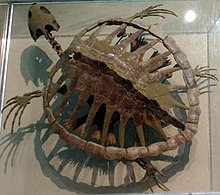Toxochelys
Appearance
| Toxochelys Temporal range: Late Cretaceous
| |
|---|---|

| |
| Fossil specimen, Smithsonian National Museum of Natural History | |
| Scientific classification | |
| Domain: | Eukaryota |
| Kingdom: | Animalia |
| Phylum: | Chordata |
| Class: | Reptilia |
| Order: | Testudines |
| Suborder: | Cryptodira |
| Family: | †Toxochelyidae |
| Genus: | †Toxochelys Cope, 1873 |
| Species | |
| |

Toxochelys (TOKS uh KEE leez[1]) is an extinct genus of marine turtle from the Cretaceous period. It is the most commonly found fossilized turtle species in the Smoky Hill Chalk, in western Kansas.[2] Toxochelys was about 2 m (6 ft) in length. There are five known species in the genus: Toxocheys bauri, Toxochelys browni, Toxochelys latiremus, Toxochelys weeks, and Toxochelys moorevillensis.[3] Phylogenetic analysis shows that Toxochelys belong to an extinct lineage of turtles transitional between modern sea turtles and other turtles.[4]
References
- ^ www.nhm.org Retrieved on May 12, 2008.
- ^ www.oceansofkansas.com Retrieved on May 12, 2008
- ^ zipcodezoo.com Retrieved on May 12, 2008.
- ^ Kear BP, Lee MS (March 2006). "A primitive protostegid from Australia and early sea turtle evolution". Biol. Lett. 2 (1): 116–9. doi:10.1098/rsbl.2005.0406. PMC 1617175. PMID 17148342.
- Cope, E. D. 1873. [On Toxochelys latiremis]. Proceedings of the Academy of Natural Sciences of Philadelphia 25:10.
- Hay, O. P. 1896. On the skeleton of Toxochelys latiremis. Publ. Field Columbian Museum, Zoological Ser. (later Fieldiana: Zoology), 1(5):101–106, pls. 14 &15.
- Case, E.C. 1898. Toxochelys. The University Geological Survey of Kansas, Part IV. 4:370–385. pls. 79–84.
- Hay, O.P. 1903. A revision of the species of the family of fossil turtles called Toxochelyidae, with descriptions of two new species of Toxochelys and a new species of Porthochelys. Bulletin of the American Museum of Natural History 21(10):177–185.
- R. Zangerl. 1953. The vertebrate fauna of the Selma Formation of Alabama. Part IV. The turtles of the family Toxochelyidae. Fieldiana: Geology Memoirs 3(4):145–277
- Nicholls, E.L. 1988. New material of Toxochelys latiremis Cope, and a revision of the genus Toxochelys (Testudines, Chelonoidea). Journal of Vertebrate Paleontology, 8(2):181–187.
- Druckenmiller, P. S., A. J. Daun, J. L. Skulan and J. C. Pladziewicz. 1993. Stomach contents in the upper Cretaceous shark Squalicorax falcatus. Journal of Vertebrate Paleontology. 13(supplement. to no. 3):33A.
- Carrino, M.H. 2007. Taxonomic comparison and stratigraphic distribution of Toxochelys (Testudines: Cheloniidae) of South Dakota. pp. 111–132 in Martin, J.E. and Parris D.C. (eds.), The Geology and Paleontology of the Late Cretaceous Marine Deposits of the Dakotas. Geological Society of America, Special Paper 427.
- Konuki, R. 2008. Biostratigraphy of sea turtles and possible bite marks on a Toxochelys (Testudine, Chelonioidea) from the Niobrara Formation (Late Santonian), Logan County, Kansas and paleoecological implications for predator–prey relationships among large marine vertebrates. Unpublished Masters thesis, Fort Hays State University, Hays, Kansas, 141 pp, Appen. I-VI.
- Matzke, A.T. 2008. A juvenile Toxochelys latiremis (Testudines, Cheloniidae) from the Upper Cretaceous Niobrara Formation of Kansas, USA. Neues Jahrbuch für Geologie und Paläontologie. Abhandlungen 249(3):371–380.
- Matzke, A.T. 2009. Osteology of the skull of Toxochelys (Testudines, Chelonioidea) (with 25 text-figures). Palaeontographica Abteilung A 288(4):93–150.
External links
